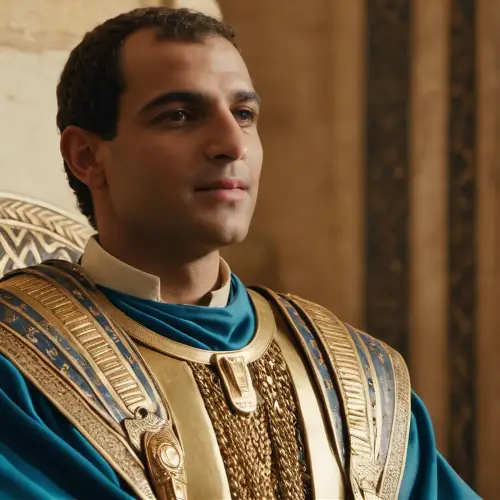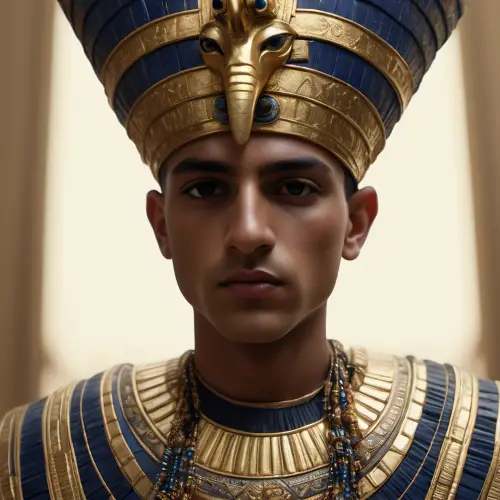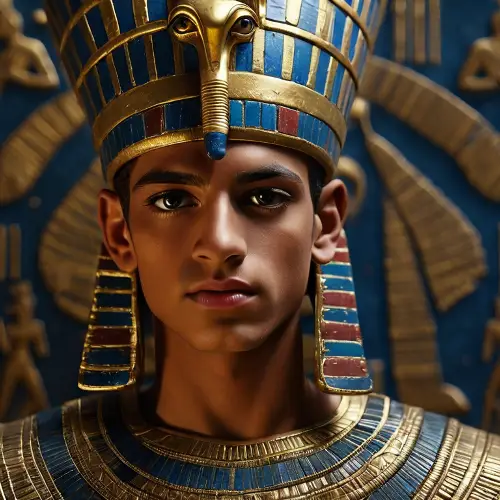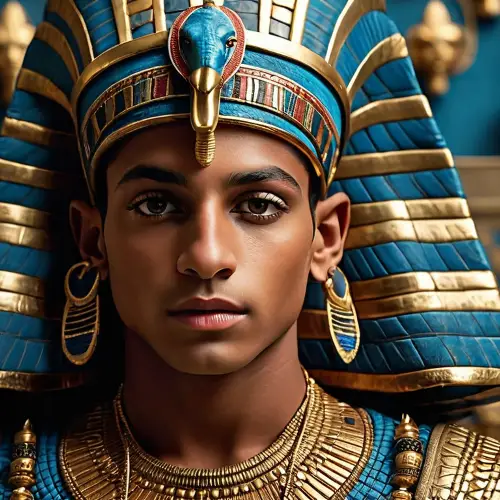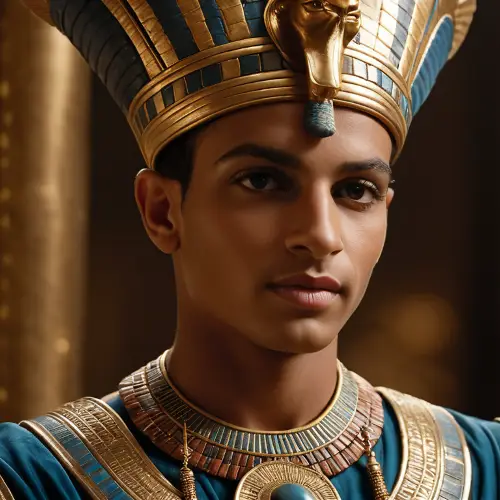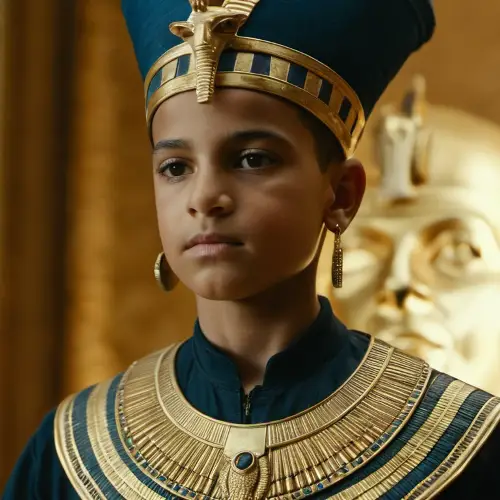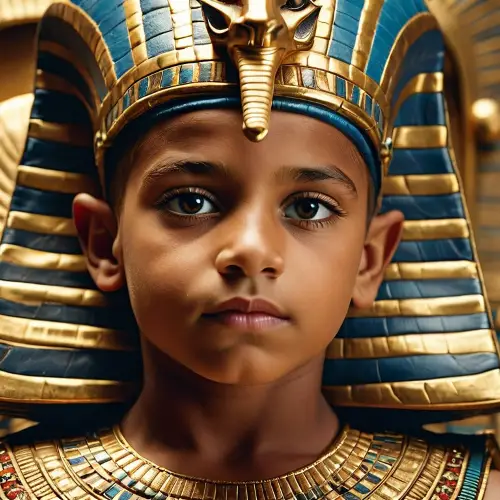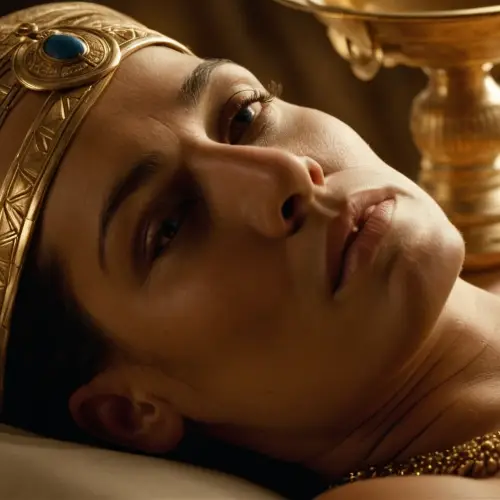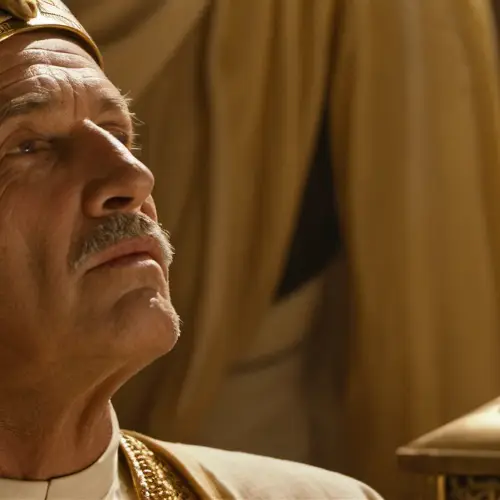More Like This
December 4, 1922. Deep beneath Egypt's sands, Howard Carter's lamp illuminates a discovery history can never forget. His breath catches at glints in the darkness - golden rays and hieroglyphs frozen since time began. As he brushes away dust from mysteries left sealed, gasps echo in that crypt where none have walked for millennia. For where he sweeps reveals not crumbling bones but solace everlasting. Gentle hands fold back shrouds with care that knows this pharaoh needs no crown, only calm forevermore. And there do the watchers see, as in dreams, a boy-king's visage undimmed through all the circlings of the sun. A nation's gift shown bright once more for eyes anew to take in Tutankhamun - pharaoh no longer lost but found, in still repose under Time's veil, regal guardian of tombs that hold fast the ancient world entire.
Dim yellow light flickers over darkened walls as figures pause in hushed anticipation. After years underground exploring Egypt's mysteries, Carter's lamp falls upon markings sealed for millennia. With bated breath they brush away the thick dust, uncovering what secrets this crypt may hold. A collective gasp arises - where dirt was piled now shimmers a gleam of gold! Hands work carefully through the layers of silt, flickering like a distant dream, revealing...not crumbled bones as was feared, but a noble visage wrapped in silent peace. Though flesh has long returned to Nile's flow, nobility's refined lines still speak through the veil of centuries. A king rests as in dreams, serenity shaping features holding fast the haunting remnants of a boy made immortal, a pharaoh found. Civilization beholds through time unravelled one who faced eternity with tranquil grace.
In the vibrant spring of 51 BCE, bathed in the warm glow of sunlight, the young Ptolemy XIII assumes his fathers mantle as the Pharaoh of Egypt. His face, a mixture of youthful innocence and the weight of responsibility, reveals the essence of a burgeoning leader.Seated beside him on the throne, Cleopatra, his sister and co-ruler, the epitome of regal grace, signifies unity and strength. Their marriage becomes a symbol of power and consolidation, promising to guide Egypts destiny hand in hand. The scene encapsulates the tender moment of an alliance, where two hearts, still in their formative years, pledge to grow together.
A youthful Tutankhamun, Pharaoh of Egypt, portrayed in his early years. He stands with regal grace, adorned in ornate garments reflecting the opulence of ancient Egyptian royalty. The intricate details of his attire and the grandeur of his headdress symbolize the power and splendor of his reign.
A youthful Tutankhamun, Pharaoh of Egypt, portrayed in his early years. He stands with regal grace, adorned in ornate garments reflecting the opulence of ancient Egyptian royalty. The intricate details of his attire and the grandeur of his headdress symbolize the power and splendor of his reign.
Tutankhamun, ascending to the throne at the age of 9, dons the regal attire of an Egyptian pharaoh, his youthful visage illuminated by the ancient splendor of Egypt.
Pharaoh Tutankhamun, the 10th ruler of Egypt's 18th dynasty, depicted in his majestic regalia, adorned with the traditional Egyptian crown and intricate jewelry. The young pharaoh, known for his reign during the New Kingdom, stands with an air of royal authority, symbolizing the grandeur of ancient Egypt.
Pharaoh Tutankhamun, the 10th ruler of Egypt's 18th dynasty, depicted in his majestic regalia, adorned with the traditional Egyptian crown and intricate jewelry. The young pharaoh, known for his reign during the New Kingdom, stands with an air of royal authority, symbolizing the grandeur of ancient Egypt.
Pharaoh Tutankhamun, the 10th ruler of Egypt's 18th dynasty, depicted in his majestic regalia, adorned with the traditional Egyptian crown and intricate jewelry. The young pharaoh, known for his reign during the New Kingdom, stands with an air of royal authority, symbolizing the grandeur of ancient Egypt.
A vivid portrayal of Pharaoh Tutankhamun reigning over Egypt from 1334 BC to 1325 BC. The scene includes the Pharaoh's regal presence and the diverse populace of Egypt.
Tutankhamun seated on the throne. In a regal setting, the young pharaoh exudes authority, adorned with royal attire and the symbols of power. The scene captures the essence of his reign as he sits majestically on the throne.
Tutankhamun seated on the throne. In a regal setting, the young pharaoh exudes authority, adorned with royal attire and the symbols of power. The scene captures the essence of his reign as he sits majestically on the throne.
In the grandeur of the Egyptian palace, Cleopatra, draped in regal attire, stands beside her young son, Ptolemy XV Philopator Philometor Caesarion. The room, adorned with symbols of ancient Egypt, bears witness to the historic moment as Cleopatra ensures a smooth transition of power.Cleopatras face reflects a mix of maternal pride and sovereign grace as she ceremoniously presents the young heir before the courtiers. The air is charged with the weight of responsibility and the promise of a new reign. The scene captures the essence of a queen securing the future, entrusting her son with the legacy of Egypt.
In the grandeur of the Egyptian palace, Cleopatra, draped in regal attire, stands beside her young son, Ptolemy XV Philopator Philometor Caesarion. The room, adorned with symbols of ancient Egypt, bears witness to the historic moment as Cleopatra ensures a smooth transition of power.Cleopatras face reflects a mix of maternal pride and sovereign grace as she ceremoniously presents the young heir before the courtiers. The air is charged with the weight of responsibility and the promise of a new reign. The scene captures the essence of a queen securing the future, entrusting her son with the legacy of Egypt.
In the grandeur of the Egyptian palace, Cleopatra, draped in regal attire, stands beside her young son, Ptolemy XV Philopator Philometor Caesarion. The room, adorned with symbols of ancient Egypt, bears witness to the historic moment as Cleopatra ensures a smooth transition of power.Cleopatras face reflects a mix of maternal pride and sovereign grace as she ceremoniously presents the young heir before the courtiers. The air is charged with the weight of responsibility and the promise of a new reign. The scene captures the essence of a queen securing the future, entrusting her son with the legacy of Egypt.
Illustrating the mystery surrounding Tutankhamun's death, envision the young pharaoh lying peacefully in his burial chamber, surrounded by the treasures of his reign. The dim glow of flickering torches reveals the intricate details of his funeral mask, symbolizing both regality and the journey to the afterlife. An air of solemnity lingers as historians ponder the secrets concealed within the ancient tomb.
Light falls softly upon gilded planes as Howard Carter lifts the lamp to better illuminate what lies before him. Wrapped in ornate linens, Tutankhamun’s mortal remains have withstood the passage of eons to offer up their historic secret. Carter’s breath catches at the king’s face, its features hauntingly lifelike through the veil of dust. Lashes kiss cheeks pressed in repose eternal, and faint colors linger upon youthful lips parted just so. Golden bands fuse with sere skin, completing the ensemble of a divine ruler returned to earthly gaze. With utmost care, the archaeologist’s hands undo each binding, easing away the noble boy’s final mask to reveal antiquity’s most evocative portrait of a soul in slumber for ages forgotten. Pharaoh’s gift unveils itself for an awestruck modern world.
November 1922. After years searching the arid sands, a glint in the torchlight stops Howard Carter's breath. Scrambling closer, he reveals through clouds of dust a step sealed tight. Images show pharaoh's riches beyond all thought, and at each breakthrough gasps echo in that crypt. Deeper they delve into dark confines guarding mysteries millenia spawn, till one gold edge shines through the last stone torn. A collective heartbeat stills as Carter wipes away the debris - he stands transfixed before painted lids that seem to never tire. With trembling care each seal is eased to disclose untouched linens treasuring pharaoh's form shut tight in slumber. Egypt's gifts at last are offered to the sun's warm gaze, as a king's riches awe the modern world through ages hurled aside.
Vast desert sands stretch as far as the eye can see, enveloping the banks of the Nile river in a golden haze. Upon the water glide ornate wooden vessels, their painted sails catching the northern breeze as oarsmen guide their way. Along the shore, figures toil - harvesting grain, drawing water, crafting wares under the watchful gaze of the Sphinx. All pay tribute to the great kings who granted this verdant strip of civilization. And towering above the dusty villages, the stepping stones of Giza jut proudly into the sky, a monument to past rulers and a reminder of Egypt's eternal nature. It is here in this timeless landscape that Pharaoh Tutankhamun reigns, overseeing an empire that has endured for millennia.
Darkness fills the chambers of Pharaoh Tutankhamun's tomb, illuminated only by the flickering flames of burning lamps. The young king lies lifeless upon his ornate bed, his once rich silks and gold now dulled by decades buried deep underground. A lone attendant bows over Tutankhamun, his hand trembling as he presses it over the pharaoh's still-warm forehead, checking in vain for any signs of life. A choked sob escapes the attendant's lips as he accepts what he has long dreaded - the curse rumored to have claimed each digger and servant working to restore the boy king's resting place has now taken its mightiest victim. Through the gloom a pair of eyes gleam sorrowfully, watching the last flicker of mortal flesh succumb to eternity's embrace.
Darkness fills the chambers of Pharaoh Tutankhamun's tomb, illuminated only by the flickering flames of burning lamps. The young king lies lifeless upon his ornate bed, his once rich silks and gold now dulled by decades buried deep underground. A lone attendant bows over Tutankhamun, his hand trembling as he presses it over the pharaoh's still-warm forehead, checking in vain for any signs of life. A choked sob escapes the attendant's lips as he accepts what he has long dreaded - the curse rumored to have claimed each digger and servant working to restore the boy king's resting place has now taken its mightiest victim. Through the gloom a pair of eyes gleam sorrowfully, watching the last flicker of mortal flesh succumb to eternity's embrace.
Darkness fills the chambers of Pharaoh Tutankhamun's tomb, illuminated only by the flickering flames of burning lamps. The young king lies lifeless upon his ornate bed, his once rich silks and gold now dulled by decades buried deep underground. A lone attendant bows over Tutankhamun, his hand trembling as he presses it over the pharaoh's still-warm forehead, checking in vain for any signs of life. A choked sob escapes the attendant's lips as he accepts what he has long dreaded - the curse rumored to have claimed each digger and servant working to restore the boy king's resting place has now taken its mightiest victim. Through the gloom a pair of eyes gleam sorrowfully, watching the last flicker of mortal flesh succumb to eternity's embrace.
A scene illustrating the side view of 9-year-old Pharaoh Tutankhamun delivering a speech in front of a vast crowd.
Tutankhamun with a congenital genetic disorder. In a regal setting, the young pharaoh is depicted with a frail physique, illustrating the impact of his congenital condition. Advisors and attendants observe, reflecting the challenges Tutankhamun faced due to his weakened health.
Dust floats like a veil in the torchlight as the archaeologists crouch in anxious anticipation. After years of careful excavation, Carter scrapes away the last of the sealing plaster to reveal a glimmer of golden skin. His breath catches at contours glimpsed through fine cracks in the ancient coating. One by one his team joins to peer inside, until the chamber rings with gasps and stifled cries at the exquisite face staring back through the centuries. This is no simple corpse left to moulder - it is pharaoh come alive, lips paused on some eternal whisper, dark lashes swept low in slumber undisturbed. With tremulous hands Carter secures wrappings to gently lift the magnificent relic into full view, unveiling for the first time a lost ruler poised as if dreaming still, immortal beauty shining through his mortal shroud. Civilization holds its breath at such a revelation wrought by the lamp's soft glow.
Dust floats like a veil in the torchlight as the archaeologists crouch in anxious anticipation. After years of careful excavation, Carter scrapes away the last of the sealing plaster to reveal a glimmer of golden skin. His breath catches at contours glimpsed through fine cracks in the ancient coating. One by one his team joins to peer inside, until the chamber rings with gasps and stifled cries at the exquisite face staring back through the centuries. This is no simple corpse left to moulder - it is pharaoh come alive, lips paused on some eternal whisper, dark lashes swept low in slumber undisturbed. With tremulous hands Carter secures wrappings to gently lift the magnificent relic into full view, unveiling for the first time a lost ruler poised as if dreaming still, immortal beauty shining through his mortal shroud. Civilization holds its breath at such a revelation wrought by the lamp's soft glow.
Tutankhamun issuing commands from the throne. In a commanding stance, the pharaoh directs with authority, surrounded by an air of regality. The scene captures the essence of leadership as Tutankhamun rules from his throne.
In the golden halls of Alexandria, Cleopatra, adorned in royal garments, solemnly presents her 3-year-old son, Caesarion, as the co-ruler Pharaoh Ptolemy XV. The room, adorned with symbols of Egyptian majesty, becomes the stage for a pivotal moment in history.Cleopatras face reflects a mix of maternal tenderness and regal authority as she places the diadem on the young Caesarions head. The air is charged with the promise of a new era as mother and son, in a poignant tableau, embody the continuity of Egypts lineage. The scene captures the essence of a queen securing her sons legacy and entrusting him with the weighty mantle of rulership.
In the golden halls of Alexandria, Cleopatra, adorned in royal garments, solemnly presents her 3-year-old son, Caesarion, as the co-ruler Pharaoh Ptolemy XV. The room, adorned with symbols of Egyptian majesty, becomes the stage for a pivotal moment in history.Cleopatras face reflects a mix of maternal tenderness and regal authority as she places the diadem on the young Caesarions head. The air is charged with the promise of a new era as mother and son, in a poignant tableau, embody the continuity of Egypts lineage. The scene captures the essence of a queen securing her sons legacy and entrusting him with the weighty mantle of rulership.
In the golden halls of Alexandria, Cleopatra, adorned in royal garments, solemnly presents her 3-year-old son, Caesarion, as the co-ruler Pharaoh Ptolemy XV. The room, adorned with symbols of Egyptian majesty, becomes the stage for a pivotal moment in history.Cleopatras face reflects a mix of maternal tenderness and regal authority as she places the diadem on the young Caesarions head. The air is charged with the promise of a new era as mother and son, in a poignant tableau, embody the continuity of Egypts lineage. The scene captures the essence of a queen securing her sons legacy and entrusting him with the weighty mantle of rulership.
A scene depicting 9-year-old Pharaoh Tutankhamun's back as he delivers a speech in front of a vast crowd.
An artistic representation of Pharaoh Tutankhamun reigning over Egypt from 1334 BC to 1325 BC.
An artistic representation of Pharaoh Tutankhamun reigning over Egypt from 1334 BC to 1325 BC.
Tutankhamun contracting malaria. In a dimly lit chamber, the young pharaoh shows signs of illness as he battles the effects of malaria. His weakened figure lies on an ornate bed, surrounded by concerned figures examining his symptoms, highlighting the historical struggle with the disease.









